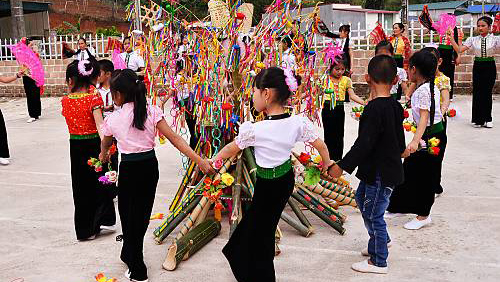HCMC – The United Nations Educational Scientific and Cultural Organization (UNESCO) has accredited the art of the Xoe dance of the Thai ethnic minority people (Xoe Thai) in Vietnam as Intangible Cultural Heritage of Humanity.
The recognition was approved at the 16th session of the UNESCO’s Intergovernmental Committee for the Safeguarding of the Intangible Cultural Heritage in Paris, France, on December 15.
According to the Intergovernmental Committee of the UNESCO, the art meets all the five criteria set by the UNESCO to be listed as Intangible Cultural Heritage of Humanity.
The UNESCO describes Xoe Thai as a form of dancing with movements that symbolize human activities in rituals, culture, life and work. It is performed at rituals, weddings, village festivals and other community events.
There are three main types of Xoe: ritual, circle and theatrical. The ritual and theatrical Xoe dances are named after props used during certain performances.
For instance, there is the scarf Xoe, the conical hat Xoe, the fan Xoe, the bamboo pole Xoe, the music Xoe, the stick Xoe and the flower Xoe. But the most popular form is the circle Xoe, wherein dancers form a circle and perform in harmony.
The basic movements include raising and opening the hands, then lowering them and clasping the hands of the adjacent person. The dancers follow rhythmic footsteps, slightly arching the chest and leaning backwards. Although simple, the dance movements symbolize wishes for community health and harmony.
The dance is accompanied by various musical instruments, including gourd lutes, mouth organs, drums, gongs, cymbals and reed flutes. The instrumental music blends with the vocals and the jingling of the silver jewellery hanging around the women’s waists.
Transmitted from generation to generation within families, dance troupes and schools, the Xoe dance has become a symbol of hospitality and an important identity marker for the Thai people in north-western Vietnam.
According to Ambassador Le Thi Hong Van, Permanent Representative of Vietnam to the UNESCO, the Thai people’s Xoe dance is the 14th intangible heritage of Vietnam to obtain the UNESCO title so far.
She said the recognition affirms the appreciation of the international community toward Vietnamese heritage and promotes Vietnam’s cultural values as well as its image of the people and the landscapes. It also reflects Vietnam’s diverse cultural identities as well as the close bonds of the community and the country’s respect for cultural diversity.
To seek UNESCO recognition, the Ministry of Culture, Sports and Tourism worked with the northern mountainous provinces of Yen Bai, Lai Chau, Son La and Dien Bien, home to the dance since 2019, to compile and complete the dossier of “The Art of Xoe Dance of the Thai People in Vietnam”.
Deputy Minister of Culture, Sports and Tourism Hoang Dao Cuong said the cultural authorities have also organized a series of activities to preserve and promote the value of Xoe Thai, such as identifying, researching, documenting and developing measures to protect the dance within the community.
Besides, the State President has granted the national honorary title to artisans practicing Xoe Thai for their contribution to the preservation of the dance.









